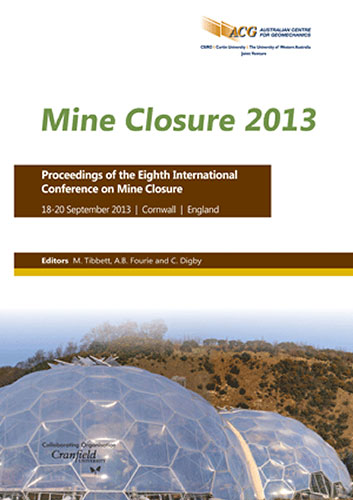Punakaiki coastal restoration project: a partnership for closure and restoration of a mineral sands project site in New Zealand

|
Authors: Rhodes, SH; Lorenzon, K; Hahner, JL; Bowie, MH; Boyer, S; Dickinson, N; Smith, C; Sharp, D Paper is not available for download Contact Us |
DOI https://doi.org/10.36487/ACG_rep/1352_38_Rhodes
Cite As:
Rhodes, SH, Lorenzon, K, Hahner, JL, Bowie, MH, Boyer, S, Dickinson, N, Smith, C & Sharp, D 2013, 'Punakaiki coastal restoration project: a partnership for closure and restoration of a mineral sands project site in New Zealand', in M Tibbett, AB Fourie & C Digby (eds), Mine Closure 2013: Proceedings of the Eighth International Seminar on Mine Closure, Australian Centre for Geomechanics, Cornwall, pp. 447-462, https://doi.org/10.36487/ACG_rep/1352_38_Rhodes
Abstract:
Following its acquisition of North Ltd in 2000, Rio Tinto acquired 114 ha of coastal land at Punakaiki on New Zealand’s South Island. Westland Ilmenite Ltd (WIL) had carried out pilot-scale mining and processing in the early 1990s but had concluded that mining would not be viable. The site had been in care and maintenance from 1994, and the plant and buildings were still present, but in poor condition. Though much of the land has been cleared for pasture, the area is of high conservation value. The site is located between the Paparoa National Park in the hills to the east and the coastal dunes, and it contains remnant coastal forest and wetlands and is adjacent to Nikau Scenic Reserve. The Paparoa National Park contains the only known breeding colonies of the vulnerable Westland Black Petrel, classified as Vulnerable in the IUCN Red List of Threatened Species. Consultations with community groups, local and regional government as well as the New Zealand Department of Conservation Te Papa Atawhai (DOC) found strong support for rehabilitating the land as a conservation area. A vision emerged from these consultations to restore the ecological corridor from the mountains to the sea, to provide a scenic gateway just south of the popular Pancake Rocks at Punakaiki. This vision led to the creation of Punakaiki Coastal Restoration Project (PCRP), a partnership between Rio Tinto, DOC and Conservation Volunteers New Zealand (CVNZ). The WIL land was gifted to DOC and became the Te Ara Taiko Nature Reserve in 2010, which forms a contiguous conservation area, including Paparoa National Park and two other reserves. The PCRP is managed by Conservation Volunteers on behalf of the partners, who oversee the project via a management committee. This structure reflects Rio Tinto’s existing 15 years relationship with Conservation Volunteers in Australia. The PCRP partnership has enabled Conservation Volunteers to establish in New Zealand and develop additional projects with the Department of Conservation, other government agencies and the corporate sector. Conservation Volunteers use the refurbished office and workshop buildings as the project administration centre and plan to use the site as a hub for its west coast activities. A plant nursery has been established, and more than 12,500 seedlings have been collected and raised to augment commercial supply. Over 5,000 volunteer days have been devoted to removing gorse and other weeds and to propagating and planting over 100,000 native forest species seedlings on 12 ha of the former pasture. Students from a local school and polytechnic are regular visitors and participate in activities that complement their studies. Visual monitoring transects have been established to monitor restoration progress, and a research collaboration has been established with Lincoln University to develop methods to monitor the restoration over the long term.
References:
Boffa Miskell (2006) Grey District Significant Natural Area Assessment PUN-124, prepared for the Grey District Council.
Boffa Miskell (2007a) Grey District Significant Natural Area Assessment PUN-W033, prepared for the Grey District Council.
Boffa Miskell (2007b) Grey District Significant Natural Area Assessment PUN-043, prepared for the Grey District Council.
Bowie, M.H., Montier, C., Boyer, S. and Dickinson, N.M. (2012a) Baseline Survey for the Punakaiki Coastal Restoration Project, Lincoln University Wildlife Management Report No. 50.
Bowie, M.H., Montier, C., Boyer, S., Dickinson, N.M., Hahner, J.L. and Smith, C.M.S. (2012b) Indicators of restoration success in a sandplain forest, presented at the New Zealand Ecological Society Conference, 25–29 November 2012, Lincoln University, Christchurch, New Zealand.
DOC (2010) West Coast Community Strategy 2010–2020.
Don, G.L. (1986) Nikau Scenic Reserve: An Appraisal of Biological Values, prepared for Grampian Mining Company by Bioresearches Limited, Auckland, New Zealand.
IUCN (International Union for Conservation of Nature) (2012) Procellaria westlandica, in IUCN Red List of Threatened Species, Version 2012.2, viewed 19 June 2013, .
Jackson, R.J. (1994) Hydrological Management of Three Wetlands, Conservation Advisory Science Notes No. 89, Department of Conservation, Wellington, New Zealand.
Murray-North (1990) Phase 1 reconnaissance survey report for Westland Illmenite Ltd.
policies.asp.
PCRP (2008) Punakaiki Coastal Restoration Project, Westland Petrel Partnering Agreement (Unpublished).
© Copyright 2025, Australian Centre for Geomechanics (ACG), The University of Western Australia. All rights reserved.
View copyright/legal information
Please direct any queries or error reports to repository-acg@uwa.edu.au
View copyright/legal information
Please direct any queries or error reports to repository-acg@uwa.edu.au